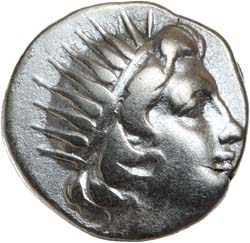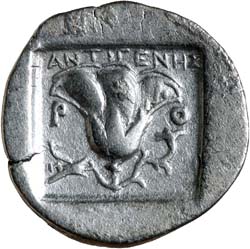Greek Silver & Bronze Coins
Lot 2574 SESSION 11 (9.30AM THURSDAY 25TH NOV) Greek Silver & Bronze Coins
Estimate $300
Bid at live.noble.com.au
SOLD $420
CARIA, Rhodes, (188-84 B.C.), silver drachm, (2.86 g), obv. Head of Helios radiate right hair in locks, rev. Inside shallow incuse square a Rose, to left P and right O, above **ANTIGENHS*, to left a prow, to right a bud, (S. 5063 variety, BMC 249, Jenkins Group A, No.17 [dated to 188-170 B.C.], SNG Keckman 632-633 (Pl.21). Bright, nearly extremely fine and rare.
Ex Classical Numismatic Group, January 20, 2008 private purchase, with ticket.
This coin coming from a large hoard as noted in CNG Mail Bid Sale 78. This late series of silver fractions was among the longest-running of all the Rhodian series. Its types continued from that found on previous issues. Helios was adopted as the patron diety of Rhodes upon the city's foundation in 407/7 BC, and became the nearly universal obverse type of Rhodian coinage over the following four centuries. The rose was a pun on the city's name, a common practice in Greek coinage, and also was the dominant type on the reverse of Rhodian coins until the first century AD. The plinthophoric series runs from circa 190 (188) BC to 84 BC, and represents a complete overhaul of the monetary system, in which the traditional Rhodian standard was abandoned in favor of a new standard based on a 'plinthophoric' drachm of around 3 grams, which was more commensurate with other currencies of the time. Another innovation was the abandonment of all denominations higher than a drachm, and a proliferation of regular issues of hemidrachms and diobols. As mentioned above, the types remained the same, but certain details were altered. On drachms and diobols Helios was now more often portrayed in profile, rather than facing, and the facing portraits on hemidrachms were now radiate. The reverse design was placed into a shallow incuse square, which is where the name of the series is derived (plinthos = brick or ingot). The exact reason for this major reorganization of Rhodian coinage is not known for certain, but the prevalent theory is that it was undertaken to conform to the changes extant under the terms of the Peace of Apameia in 188 BC. Whatever the reason, this change was enduring, with the series lasting nearly 100 years. The plinthophoric coinage came to an end during the First Mithridatic War, during which the Roman survivors of the Vespers of 88 BC fled to Rhodes, which was subsequently besieged by the Pontic king. The siege lasted for six months, during which time the silver supply had dwindled to such low quantities that the coinage was supplanted by issues of large-denomination bronzes (see Ashton, Coinage, pp. 61-5).
Estimate / sale price does not include buyer's premium (currently 22% including GST) which is added to hammer price. All bids are executed on the understanding that the Terms & Conditions of sale have been read and accepted. For information on grading and estimates please refer to the Buying at Auction advice.
Quick find
View a lot by number and sale.
Adjacent lots
Lot 2572
CARIA, Carian Islands, Rhodes, (c.265-250 B.C.), silver didrachm, (6.57 g), obv. head of Helios three-quarter ...
Estimate $1,200
Lot 2573
CARIA, Rhodos, (c.205-190 B.C.), silver didrachm, (5.51 g), obv. radiate head of Helios three-quarter face ...
Estimate $1,500
Lot 2574 This lot
CARIA, Rhodes, (188-84 B.C.), silver drachm, (2.86 g), obv. Head of Helios radiate right hair ...
Estimate $300
Lot 2575
PHRYGIA, Mysia Abbaitis, (2nd century B.C.), AE 20 (7.73 g), obv. laureate head of Zeus ...
Estimate $120
Lot 2576
LYCIA, Masicytes, (Lycian League), Augustus, silver drachm, as coinage of the Lycian League, (28/7 - ...
Estimate $300

